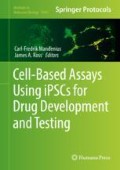Abstract
FLIPR-based calcium assay enables the detection and characterization of neuronal excitability by using electrical field stimulation to evoke and record action potential-driven calcium transients in induced pluripotent stem cell (iPSC)-derived cortical forebrain neurons. Here we describe high throughput measurement of neuronal excitability with a defined electrostimulation paradigm in a 384-well plate format using FLIPR.
Access this chapter
Tax calculation will be finalised at checkout
Purchases are for personal use only
Reference
Eijkelkamp N et al (2012) Neurological perspectives on voltage-gated sodium channels. Brain 135(Pt 9):2585–2612
Hedrich UB et al (2014) Impaired action potential initiation in GABAergic interneurons causes hyperexcitable networks in an epileptic mouse model carrying a human Na(V)1.1 mutation. J Neurosci 34(45):14874–14889
Frazzini V et al (2016) Altered Kv2.1 functioning promotes increased excitability in hippocampal neurons of an Alzheimer’s disease mouse model. Cell Death Dis 7:e2100
Lasarge CL, Danzer SC (2014) Mechanisms regulating neuronal excitability and seizure development following mTOR pathway hyperactivation. Front Mol Neurosci 7:18
Mertens J et al (2015) Differential responses to lithium in hyperexcitable neurons from patients with bipolar disorder. Nature 527(7576):95–99
Wainger BJ et al (2014) Intrinsic membrane hyperexcitability of amyotrophic lateral sclerosis patient-derived motor neurons. Cell Rep 7(1):1–11
Virdee JK et al (2017) A high-throughput model for investigating neuronal function and synaptic transmission in cultured neuronal networks. Sci Rep 7(1):14498
Grynkiewicz G, Poenie M, Tsien RY (1985) A new generation of Ca2+ indicators with greatly improved fluorescence properties. J Biol Chem 260(6):3440–3450
Berridge MJ, Lipp P, Bootman MD (2000) The versatility and universality of calcium signalling. Nat Rev Mol Cell Biol 1(1):11–21
Berridge MJ (1998) Neuronal calcium signaling. Neuron 21(1):13–26
Mezler M et al (2012) Development and validation of a fluorescence-based HTS assay for the identification of P/Q-type calcium channel blockers. Comb Chem High Throughput Screen 15(5):372–385
Smetters D, Majewska A, Yuste R (1999) Detecting action potentials in neuronal populations with calcium imaging. Methods 18(2):215–221
Shi Y, Kirwan P, Livesey FJ (2012) Directed differentiation of human pluripotent stem cells to cerebral cortex neurons and neural networks. Nat Protoc 7(10):1836–1846
Author information
Authors and Affiliations
Corresponding author
Editor information
Editors and Affiliations
Rights and permissions
Copyright information
© 2019 Springer Science+Business Media, LLC, part of Springer Nature
About this protocol
Cite this protocol
Kizner, V., Fischer, S., Jähnke, B., Naujock, M. (2019). Assessing Neuronal Excitability on a Fluorometric Imaging Plate Reader (FLIPR) Following a Defined Electrostimulation Paradigm. In: Mandenius, CF., Ross, J. (eds) Cell-Based Assays Using iPSCs for Drug Development and Testing. Methods in Molecular Biology, vol 1994. Humana, New York, NY. https://doi.org/10.1007/978-1-4939-9477-9_20
Download citation
DOI: https://doi.org/10.1007/978-1-4939-9477-9_20
Published:
Publisher Name: Humana, New York, NY
Print ISBN: 978-1-4939-9476-2
Online ISBN: 978-1-4939-9477-9
eBook Packages: Springer Protocols

